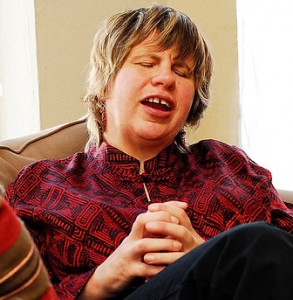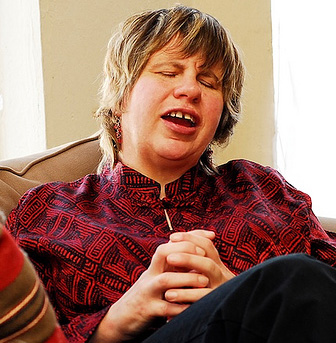Empathy for the Next Time: A Response to Transforming Church Conflict: Compassionate Leadership in Action – Lisa Larges
 What I’m wondering now, some two years after the vote in my denomination, (the Presbyterian Church U.S.A.) to remove the bar to ordination for lgbt persons, what I’m wondering now as someone who is a part of that lgbt community, what I’m wondering now, even as we live out the denouement of that struggle, with churches leaving and the question of marriage for same gender couples still before us, what I’m wondering now, remembering those forty some years of conflict—remembering the parliamentary maneuverings and high stakes votes and judicial actions and attempts toward dialogue and church-wide studies and appointed task forces and—what I’m wondering now, feeling the weight of the needless pain that we, as a church inflicted, what I’m wondering now is: Could we have done it better? Across that forty-year span, could we have worked out our differences with less rancor and divisiveness and objectivizing and bad behavior and fear of one another?
What I’m wondering now, some two years after the vote in my denomination, (the Presbyterian Church U.S.A.) to remove the bar to ordination for lgbt persons, what I’m wondering now as someone who is a part of that lgbt community, what I’m wondering now, even as we live out the denouement of that struggle, with churches leaving and the question of marriage for same gender couples still before us, what I’m wondering now, remembering those forty some years of conflict—remembering the parliamentary maneuverings and high stakes votes and judicial actions and attempts toward dialogue and church-wide studies and appointed task forces and—what I’m wondering now, feeling the weight of the needless pain that we, as a church inflicted, what I’m wondering now is: Could we have done it better? Across that forty-year span, could we have worked out our differences with less rancor and divisiveness and objectivizing and bad behavior and fear of one another?
Because I still carry the pain of it inside of me. I do. And others, perhaps lots of us do as well.
I carry the pain of those beautiful people, gay, lesbian, bi, transgender, queer, who believed the lie that our church propagated and/or tolerated that they were sinful and perverted. I carry the weight of all those who left, and I mourn the loss of their gifts, their wisdom, their leadership and their faithfulness. I carry the stories and the memory of those lgbt folks who were told again and again by well-meaning supportive church leaders to wait, and then to wait some more. Some of those bright, gentle, beautiful lgbt people, as it turned out, didn’t have the luxury of time to wait.
Slice it one way and the fight over lgbt inclusion was a ideological battle between liberals and conservatives—and I know just how laden and inadequate those terms are. Within that larger conflict over the authority of Scripture, church governance, and other matters over which liberal and conservative Christians regularly tussle, lgbt persons occupied contested ground. Earlier church fights within the denomination put African-Americans, women, divorced persons, and immigrants, to name a few, into that contested space. To occupy contested space is to be objectified, dehumanized, and to be suspect not for what you do or believe but for who you are. And I keep wondering, can we begin the work now of making strategic changes to our church structures and governance so that the next marginalized community that we push into that contested space will at least suffer a little less?
Largely, the forty-year fight in the Presbyterian Church over lgbt ordination was an exercise in talking past one another. We worked our way into an impasse, and there we stayed for many years, more or less evenly divided. Over and over and over again, in debate after debate, speakers would line up, pro and con, and make the same arguments. Because there was a lot of time to fill and not many arguments to make we simply made them again and again with more ardor or eloquence or intensity.
Time and time again, I would hear someone on the liberal side give their analysis of the conservative mind. I did this plenty myself. We’d say something like, “they have a fear of change,” or, “They’re stuck in black and white thinking.” Usually this was well-meant; a groping after explanation, but it was reductionist and diminishing and flat-out wrong. I can imagine that conservatives had their own pet theories about liberals. True empathy was hard to come by. We mostly didn’t have the tools for it.
We carry the pain of that too. The distances between us that we couldn’t, or wouldn’t, or didn’t bridge. The ways in which I, for instance, as a liberal, couldn’t or wouldn’t or didn’t hear within the concern of conservatives for the preeminence of Scripture a need for integrity and clarity, and perhaps even something more that I wasn’t fully open to comprehend.
In that forty-year struggle there were surely many occasions when those distances were indeed bridged, and I don’t mean to negate their significance. They were moments of clear unalloyed grace, when we met one another with vulnerability, humility, and compassion. Here and there too, we took institutional steps to promote that bridging. Now, when our commissioners meet at the General Assembly (our national policy setting gathering) you’ll hear far many more pauses for prayer and for informal sharing then twenty or even ten years ago. How do we now lend our energy and creativity toward promoting more of those moments, toward making room for grace to settle in upon us? Can we step back and take a hard look at church conflict so as to begin to transform it in productive, life-giving ways?
Church fights, on a national or local scale, whether they are about the Trinity, or marriage equality, or the color of the carpet in the sanctuary have intensity and a capacity for destruction that’s unparalleled except perhaps within families. This is so perhaps because religion, like family, meets us at the level of human need. Belonging, purpose, meaning, integrity, love—these and other needs are primal, and we react with a fierce intensity when they are not met or are threatened.
There are plenty of books out there setting out various models to help churches navigate conflict. In one way, Transforming Church Conflict: Compassionate Leadership in Action is one more such book, and Nonviolent Communication (NVC) is one more such model. Like other models it promotes good communication-hygiene: name what is happening objectively, without judgment or analysis, identify your own feelings, and make specific, doable requests.
The specific contribution of Nonviolent Communication to working through conflict is its emphasis on identifying and moving to meet needs. Nonviolent Communication cultivates empathy as a way to recognize need and discover how best to answer it. To satisfy need is to promote human flourishing. Strategies to meet needs can and often do clash, but NVC maintains that needs do not conflict. NVC is a process for loosening our fierce hold on our strategies, and “dwelling in the beauty of need,” both our own and another’s.
Christian faith rests on the central insight into humanity’s need for salvation, expressed in our hunger for God and our reliance on grace. In this way, the principles of Nonviolent Communication fit neatly within Christian theology and practice. That salvific need is met in Christ, which is to say in both a transcendent and incarnational way. To put it more directly, as Scripture does, we have within us the need to love God and to know God’s love, to love one another and to be loved. Nonviolent Communication is a practice that opens us to be empathetically alive to those needs.
Transforming Church Conflict: Compassionate Leadership in Action offers a theological and Scriptural framework for understanding Nonviolent Communication. More important, for all of us who feel this longing to find healing in and through and beyond church fights, the book and the process it lays out offer not just another model, or some new tools, but rather a spiritual discipline.
In other words, it’s what I can do now. Nonviolent Communication offers me a spiritual practice—a practice of learned empathy that can be a starting point for at least changing what I bring to the church. I hope that this book, Transforming Church Conflict: Compassionate Leadership in Action can open the conversation for building on that practice. If so, I want to be a part of it.
Lisa Larges has worked for many years toward full inclusion and welcome of gay, lesbian, bisexual and transgender persons in the Presbyterian Church (USA). She is active at Lake Nokomis Presbyterian Church in Minneapolis and is a candidate for ministry in the PC(USA). She works as the Training and Outreach Coordinator for State Services for the Blind of MN.


Thank you, Lisa. I, too, still feel the pain, and it was never as bad for me as it was for you. Thank you for naming this pain.
Lisa, Thank you for your sharing your brilliance about this complex subject. I, too, have been in conflict with the church for their view (in fact, left the church)& hateful behavior. Lake Nokomis is a breath of fresh air. Gratefully, Sandy
Lisa, many thanks for this piece … it was, and remains so, a painful time for the PCUSA. I was ordained in 1970, and in ’76, I read my first GA papers on ordination for lgbtq persons, so the question/questions have pretty much defined the whole of my ministry.
After a struggle, there are always good questions to ask – such as, “Could it have been done differently?” Perhaps, but history seems to make it clear that we human beings rarely make social progress without struggle, and sometimes serious, bloody, struggle. But the conflict never feels good, and it leaves everyone tainted, because “we’ve all fallen short of the glory of God.”
Joshua’s word to Israel still stands in crucial moments: “Choose today whom you will serve.” And Paul’s words, as well, “If possible, to the best of your ability, live at peace with all people.” I suppose we live in between these two notes. Yet, even Paul makes it clear, “If possible” because peace isn’t always possible … and sometimes we have to rely on what’s said about Jesus – he didn’t come for peace, but for the sword.
To jump too quickly to the sword is folly; to refuse the sword is cowardice. To know the difference and when – well, that’s wisdom, and wisdom usually learned the hard way.